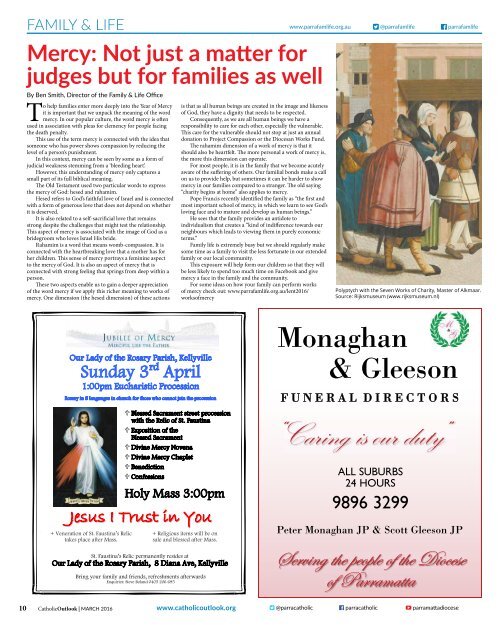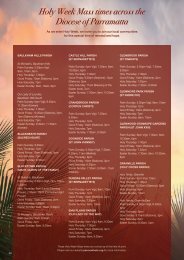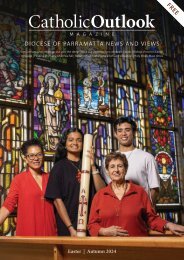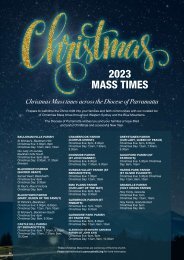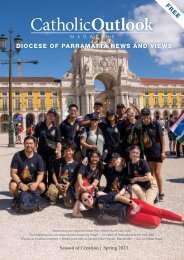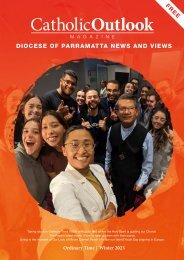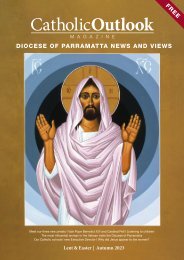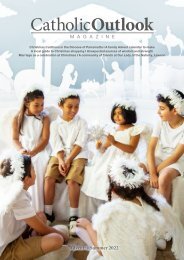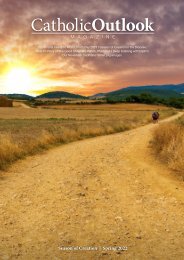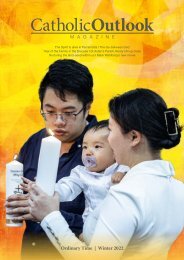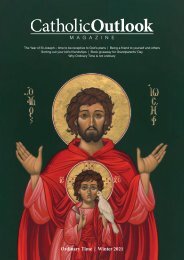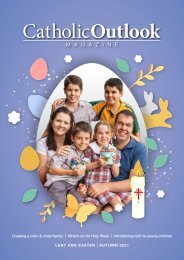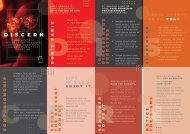Catholic Outlook March 2016
Create successful ePaper yourself
Turn your PDF publications into a flip-book with our unique Google optimized e-Paper software.
FAMILY & LIFE www.parrafamlife.org.au @parrafamlife parrafamlife<br />
Mercy: Not just a matter for<br />
judges but for families as well<br />
By Ben Smith, Director of the Family & Life Office<br />
To help families enter more deeply into the Year of Mercy<br />
it is important that we unpack the meaning of the word<br />
mercy. In our popular culture, the word mercy is often<br />
used in association with pleas for clemency for people facing<br />
the death penalty.<br />
This use of the term mercy is connected with the idea that<br />
someone who has power shows compassion by reducing the<br />
level of a person’s punishment.<br />
In this context, mercy can be seen by some as a form of<br />
judicial weakness stemming from a ‘bleeding heart’.<br />
However, this understanding of mercy only captures a<br />
small part of its full biblical meaning.<br />
The Old Testament used two particular words to express<br />
the mercy of God: hesed and rahamim.<br />
Hesed refers to God’s faithful love of Israel and is connected<br />
with a form of generous love that does not depend on whether<br />
it is deserved.<br />
It is also related to a self-sacrificial love that remains<br />
strong despite the challenges that might test the relationship.<br />
This aspect of mercy is associated with the image of God as a<br />
bridegroom who loves Israel His bride.<br />
Rahamim is a word that means womb-compassion. It is<br />
connected with the heartbreaking love that a mother has for<br />
her children. This sense of mercy portrays a feminine aspect<br />
to the mercy of God. It is also an aspect of mercy that is<br />
connected with strong feeling that springs from deep within a<br />
person.<br />
These two aspects enable us to gain a deeper appreciation<br />
of the word mercy if we apply this richer meaning to works of<br />
mercy. One dimension (the hesed dimension) of these actions<br />
is that as all human beings are created in the image and likeness<br />
of God, they have a dignity that needs to be respected.<br />
Consequently, as we are all human beings we have a<br />
responsibility to care for each other, especially the vulnerable.<br />
This care for the vulnerable should not stop at just an annual<br />
donation to Project Compassion or the Diocesan Works Fund.<br />
The rahamim dimension of a work of mercy is that it<br />
should also be heartfelt. The more personal a work of mercy is,<br />
the more this dimension can operate.<br />
For most people, it is in the family that we become acutely<br />
aware of the suffering of others. Our familial bonds make a call<br />
on us to provide help, but sometimes it can be harder to show<br />
mercy in our families compared to a stranger. The old saying<br />
“charity begins at home” also applies to mercy.<br />
Pope Francis recently identified the family as “the first and<br />
most important school of mercy, in which we learn to see God’s<br />
loving face and to mature and develop as human beings.”<br />
He sees that the family provides an antidote to<br />
individualism that creates a “kind of indifference towards our<br />
neighbours which leads to viewing them in purely economic<br />
terms.”<br />
Family life is extremely busy but we should regularly make<br />
some time as a family to visit the less fortunate in our extended<br />
family or our local community.<br />
This exposure will help form our children so that they will<br />
be less likely to spend too much time on Facebook and give<br />
mercy a face in the family and the community.<br />
For some ideas on how your family can perform works<br />
of mercy check out: www.parrafamlife.org.au/lent<strong>2016</strong>/<br />
worksofmercy<br />
Polyptych with the Seven Works of Charity, Master of Alkmaar.<br />
Source: Rijksmuseum (www.rijksmuseum.nl)<br />
Our Our Lady of of the Rosary Parish, Kellyville<br />
Sunday 3 rd April<br />
1:00pm Eucharistic Procession<br />
Rosary Rosary in 5 in 5 languages in in church for those who cannot join the procession<br />
Blessed Sacrament street procession<br />
with the Relic of St. Faustina<br />
Exposition of the<br />
Blessed Sacrament<br />
Divine Mercy Novena<br />
Divine Mercy Chaplet<br />
Benediction<br />
Confessions<br />
Holy Mass 3:00pm<br />
Jesus I I Trust in You<br />
+ Veneration + Veneration of of St. St. Faustina’s Faustina’s Relic Relic<br />
+ Religious items items will will be be on on<br />
takes<br />
takes<br />
place<br />
place<br />
after<br />
after<br />
Mass.<br />
Mass.<br />
sale<br />
sale and<br />
and<br />
blessed<br />
blessed<br />
after<br />
after<br />
Mass.<br />
Mass.<br />
St.<br />
St.<br />
Faustina’s<br />
Faustina’s<br />
Relic<br />
Relic<br />
permanently<br />
permanently resides<br />
resides<br />
at<br />
at<br />
Our Our Lady Lady of of the the Rosary Rosary Parish, 8 Diana Ave, Ave, Kellyville Kellyville<br />
Bring your family and friends, refreshments afterwards<br />
Bring your family and friends, refreshments afterwards<br />
Enquiries: Steve Boland 0405 206 695<br />
Enquiries: Steve Boland 0405 206 695<br />
10 <strong>Catholic</strong><strong>Outlook</strong> | MARCH <strong>2016</strong><br />
www.catholicoutlook.org


